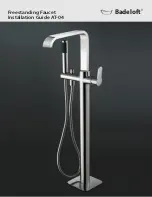
10
Fig.10
Fig.11
WARNING
Check there are no hidden cables or pipes
before drilling holes for wall plugs. Use great
care when using power tools near water.
The use of a residual current device (RCD) is
recommended when using power tools.
• Use the backplate as the template making
sure it is level and mark the fixing holes
(fig.10)
.
• Remove the unit from the wall. Drill and plug
the wall.
(An appropriate drill bit should be used.
If the wall is plasterboard or a soft building block,
appropriate wall plugs should be fitted).
• Screw the top fixing screw into position
leaving the base of the screw head protruding
6mm out from the wall.
• Hook the backplate over the top screw and
fit the remaining fixing screws into position,
but
DO NOT
fully tighten the screws at
this stage. The fixing holes are elongated to
allow for out of square adjustment after the
plumbing connection has been completed.
• Fit the nut and olive onto the pipework
(fig.11)
and connect the mains water pipe
fitting to the inlet of the shower.
•
DO NOT
use excessive force when making
the connection.
• Make sure the backplate is square on the wall
and tighten the retaining screws which hold
it to the wall.
• Before turning on the mains water supply
ensure that the
start/stop
mechanism is in
the
off
position
(fig.12)
.
• Turn on the mains water supply and check
for leaks in the pipework connection to the
shower.
NOTE:
When the mechanism is in the ‘OFF’
position, no water can flow through the unit.
IMPORTANT:
A suitable sealant should always
be used to seal around the incoming pipework to
prevent water entering the wall.
7
Continued
SECTION
Olive
Nut
If the mechanism
is in the ‘
ON
’
position, press
once and release
The image below
shows the ‘
OFF
’
position
Mechanism
shown in the
‘
OFF
’ position
Fig.12
Mechanism
Содержание BLACK CHIC
Страница 25: ...21 ...














































